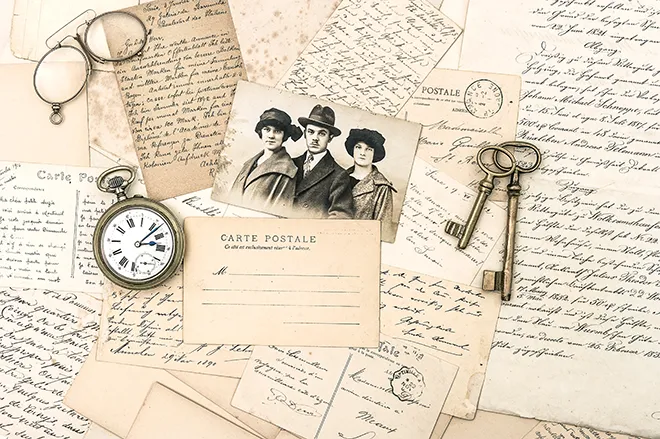
Commentary - A century ago, an explosion of free thought burst from Kansas. It filled pockets — and minds.
Funny the things you hold on to.
On my desk is a printing block from one of the Little Blue Books, produced in the millions by the Haldeman-Julius plant in Girard, Kansas. It’s a chunk of metal and wood, and it still has black ink crusted around its reverse characters. Numbered 1020 in the series and used to print the title page of a 1926 essay by iconoclast botanist Luther Burbank, the block is a piece of history speaking from the dead but not yet distant past.
It is a bit of permanence in an increasingly ethereal world of thought.
More on that later.
I picked up the printing block during my first year or so as a reporter for the Pittsburg Morning Sun, a small daily in Southeast Kansas. I don’t recall exactly where the block came from, but I likely bought it at some yard sale, because in those days it wasn’t uncommon to find jetsam from the old Haldeman-Julius publishing empire.
Beginning in 1919, the plant began churning out the Little Blue Books for mail-order at a few cents each, a “university in print.” The little books were the creation of Emanuel Julius, who was just 26 when he stepped off the train at Girard. An Eastern intellectual and writer with no formal education, and the second generation of an immigrant Ukrainian Jewish family, Julius must have seemed an odd character to the town’s residents. As a reporter, he had covered the New York Triangle Shirtwaist Factory fire of 1911, in which 146 mostly immigrant workers died. Now he had come to join the staff of The Appeal to Reason, the largest socialist newspaper in the country.
I remember local historian Gene DeGruson first telling me the story of the Appeal to Reason, and of the coal mining area’s rich history of socialism. The newspaper was founded by J.A. Wayland, who had relocated the weekly from Kansas City, Missouri, to cut costs. Socialism was a significant American movement from its roots in the utopian communities of the 19th century through the presidential campaigns of Eugene V. Debs, who was convicted and imprisoned for sedition late in life. During World War I, the socialist movement — which had been strongly anti-military — began to wane.
Meanwhile, Emanuel Julius had married Marcet Haldeman, the free-thinking, wealthy and writerly daughter of a local banker. At the suggestion of Marcet’s aunt, the social reformer Jane Addams, the couple hyphenated their names.
In 1917, the Appeal was sold to Emanual and Marcet Haldeman-Julius, and the couple reimagined the newspaper for a new progressive era. Emanuel also embarked on a publishing venture that he had thought about since he was a teenager and “The Ballad of Reading Gaol” had sustained him during a cold winter’s day. His goal was to bring classics of literature to the masses in pocket-sized editions at an affordable price. In 1919, the Haldeman-Julius plant began publishing the little books. They originally had red covers, but eventually Haldeman-Julius settled on blue covers, and Oscar Wilde’s long poem would become No. 2 in the series.
The price? A nickel. By mail order.
The Little Blue Books, which preceded mass market paperbacks by a decade or two, were an unqualified success. They were carried in the pockets of hobos, working people, and aspiring writers from Saul Bellow to Louis L’Amour. E. Haldeman-Julius bolstered the classic (and royalty-free) books with new material and often used suggestive or shocking titles for appeal. No. 1402, by Arkansas socialist Clay Fulks, is “How I Went to the Devil.” No. 907, by researcher William J. Fielding, is “Sexual Obsessions of Saints and Mystics.” Collectively, the little books sold in the hundreds of millions, making E. and Marcet Haldeman-Julius not only rich, but also famous.
The couple collaborated on an ambitious set of literary projects, including the novel “Dust.” Published in 1921 by Brentano’s, New York, the work was hailed as an important work of American realistic fiction.
In his 2017 biography of E. Haldeman-Julius, historian R. Alton Lee argues that from 1920 to 1950, Girard was the “literary and publishing Mecca of the United States, and thus the international center for Western civilization.” At the height of his success, E. Haldeman-Julius knew every major author, many of the minor ones, and even if the important political figures of the day didn’t speak to him directly, they read his books. His life, Lee said, was full of scandal, disappointment, and ultimately tragedy.
What E. Haldeman-Julius left behind was a publishing and marketing revolution that changed us, a revolution that made available to every working man and woman the greatest thinkers of every age, including their own. The evidence is in the printing plates and the millions of books they produced, which are collected and catalogued by universities but which you can still find at yard sales across the country.
I was reminded of the value of non-volatile media the other day when I went to a used vinyl record store in Lawrence and redeemed a gift certificate from a friend. The place was not quaint, but authentic. The ancient floors creaked underfoot, and a shop cat roamed at will. One of the things I found was something I hadn’t realized I needed: a 1966 LP entitled “Whistle Echoes of the Ohio and Mississippi River Steamboats, Vol. 2.” One of my current writing projects is about a steamboat plying rivers of the American West.
The record has such treasures as “the plaintive call of the KATIE STOCKDALE” and the steam calliope of the “DELTA QUEEN.” The album features extensive notes, including this: “The joy of this record is that the performers who blow the whistles, sing the songs and play the music are exuberant rivermen and shore watchers along the willow-fringed winding channels of the Mississippi River System.”
Yes, I am such a research nerd that this $3 LP was the cherry on top of a good day. There was pleasure holding it in my hands, of reading the copy, of not having to deal with a menu or a scroll bar to navigate its secrets. But there was something else that occurred to me on the drive home.
There were no advertisements jiggling on the screen, no pop-ups to block, and no algorithm attempting to predict what I was most likely to buy or click on next. I had found the album by good old-fashioned browsing, not the kind you do on a device. I did not have to fight unseen agents attempting to steer my attention to other products, other sites, other candidates.
It felt like freedom.
The album was inviolable.
Like a newspaper or a magazine or a book, the album could be crushed or shredded or burned, but short of destruction its contents could not easily be altered. As we venture further into our current dystopian landscape, I suspect this resistance to alteration will prove an advantage. In past weeks, government websites have been scrubbed to conform to political orthodoxy. The malleable nature of the web makes it easy to remove historical references that might fall under the forbidden category of Diversity, Equity and Inclusion. Mentions of transgender and queer people were struck, for example, from a National Park Service web page for the Stonewall monument in New York.
Such straightwashing is mandated by executive order.
For better or worse, we live in a digital age, and our perception of reality is created by what appears on our screens. It is appalling to us now that the government is scrubbing official content in this way, but I suspect we could acclimate quickly. There are, of course, archives that store past versions of web pages, but browsing is difficult. You have to know what you’re looking for. Think your digital content is safe? You can’t even archive your Kindle library anymore, because Amazon now prevents downloads to your computer of the books you’ve already bought. Your content automatically changes to reflect updates — or deletions. We don’t own digital content, we just rent it.
If you want to keep something, you’d better buy the actual book.
Making a connection with a physical book is a reminder that you and it are of the world. There is comfort in the feel and smell and heft of books, new and old. They were our first mass medium and they remain vital in communicating important, world-changing ideas. Most of us can readily name the handful of books that shaped our lives. Near the top of my list is 1975’s “The Monkey Wrench Gang.”
Yes, this seems an old-fashioned idea, this longing for physical media, and just what you’d expect from a writer who advocates for AM radio and old stereo receivers. But the danger posed by cultural amnesia is real, and social media has far too much influence on current politics.
Barbara F. Walters, author of “How Civil Wars Start: And How to Stop Them,” has said that since social media emerged in 2010, the number of global democracies have decreased. To help prevent civil wars, she said, social media should be regulated. It’s not that people shouldn’t be allowed to post whatever they want, she argues, but that tech companies shouldn’t be allowed to push extreme material to wide audiences.
“People ask me: ‘What’s the single easiest thing that the United States could do to reduce our risk of civil war?’ And my answer is always the same,” she said in an interview cited by Business Insider. “Regulate social media.”
The history of mass media has always been turbulent, right back to the invention of the printing press and the explosion of literacy that created the modern world. In many ways, the challenges we face today are similar, but with a significant difference: The Gutenberg revolution did not have unseen agents behind each page manipulating readers for attention. A thirst for knowledge was motivation enough to turn each page.
We have failed to use new technologies responsibly — both as creators and as consumers. Never mind the easy access to pornography, as that has been with us at the start of just about every media revolution. No, it’s the malleability of new media that invites authoritarians to purge or discourage “improper ideology” that is the real danger.
If we cannot stem the shifting sand of new media, we will be buried by it.
I don’t know what E. Haldeman-Julius would make of our current situation, but I’ll bet he would recruit the best writers to offer commentary. In his time, he had Will Durant and Upton Sinclair in his stable. Perhaps in a future time a scholar will sift through the digital remains of our age and note a few voices still worth listening to, even on something as old-fashioned as a Web page.
The undoing of E. Haldeman-Julius began in February 1948, when a couple of small-time crooks broke into the printing plant in Girard. The thieves, Raymond Lee and his older brother, Joseph, found a tin can in which Haldeman-Julius had hidden $40,218 in currency and silver. That would be like stealing half a million in today’s money.
Haldeman-Julius reported the theft to the police. He was then investigated for tax fraud, because he had claimed an income of far less in preceding years. During his trial, in 1951, his defense attorney claimed his self-taught client knew little about accounting. “Nobody but a writer,” the Associated Press reported the attorney as saying, “would keep $40,000 in a tin can safe.”
Haldeman-Julius was convicted of tax evasion and sentenced to six months in prison. He and Marcet had divorced in 1933; she died eight years later, age 51. Emanuel married Susan Haney, a secretary in the publishing office.
Out on bond while awaiting appeal, Haldeman-Julius was found dead in the swimming pool of his home July 31, 1951. He was 62. Unlike Gatsby, he had died of natural causes. The age of the Little Blue Books had passed, but the printing plant in Girard kept limping along until 1978, when a presumed bottle rocket burned it to the ground.
The Haldeman-Julius legacy remains, an inviolable record for future generations. Scattered in university collections and the homes and minds and hearts of the curious and the bookish, it endures as a testament to where we’ve been. The canon is both sacred and profane, trash and treasure, a curious mix of socialism and capitalism.
In other words, it’s like us. Who we were — and who we are now, and what we hope to become — is worth preserving. No matter how much others may want us to forget.
Some things are worth holding on to.
Max McCoy is an award-winning author and journalist.















